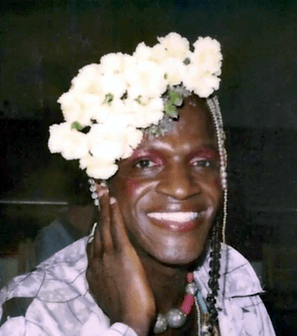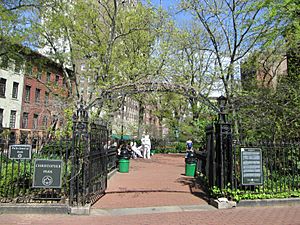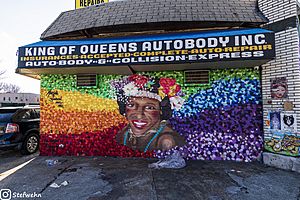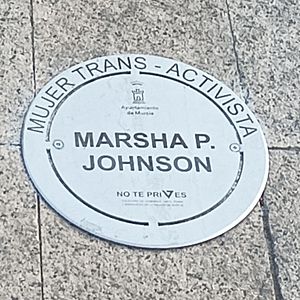Marsha P. Johnson facts for kids
Quick facts for kids
Marsha P. Johnson
|
|
|---|---|
 |
|
| Born |
Malcolm Michaels Jr.
August 24, 1945 Elizabeth, New Jersey, U.S.
|
| Died | July 6, 1992 (aged 46) |
| Known for | Gay liberation and AIDS activist, performer with the Hot Peaches and the Angels of Light |
Marsha P. Johnson (August 24, 1945 – July 6, 1992) was an American gay liberation activist and self-identified drag queen. Known as an outspoken advocate for gay rights, Johnson was one of the prominent figures in the Stonewall uprising of 1969.
Johnson was a founding member of the Gay Liberation Front (GLF) and co-founded the radical activist group Street Transvestite Action Revolutionaries (STAR), alongside close friend Sylvia Rivera. Popular in New York's gay community, Johnson was also active in the City's art scene, modeling for Andy Warhol and appearing onstage with the drag performance troupe Hot Peaches. Johnson was known as the "mayor of Christopher Street" for being a welcoming presence in the streets of Greenwich Village. Beginning in 1987, Johnson was an AIDS activist with ACT UP.
Contents
Biography
Early life
Marsha P. Johnson was born Malcolm Michaels Jr. on August 24, 1945, in Elizabeth, New Jersey, to father Malcolm Michaels Sr., an assembly line worker at General Motors, and mother Alberta Claiborne, a housekeeper. They were raised alongside six siblings, and the family attended Mount Teman African Methodist Episcopal Church. Commenting on this upbringing, Johnson said, "I got married to Jesus Christ when I was sixteen years old, still in high school."
Johnson first began wearing dresses at the age of five but stopped temporarily due to being mocked by boys who lived nearby. Johnson's mother reportedly said that being homosexual was like being "lower than a dog", but Johnson said that she was unaware of the LGBT community. Johnson's mother also encouraged them to find a "billionaire" boyfriend or husband to take care of (Johnson) for life, a goal they often talked about.
After graduating from Edison High School (now the Thomas A. Edison Career and Technical Academy) in Elizabeth in 1963, Johnson left home for New York with $15 and a bag of clothes. They waited tables after moving to Greenwich Village in 1966.
Performance work and identity
Johnson initially used the moniker "Black Marsha" but later decided on the drag queen name "Marsha P. Johnson", getting Johnson from the Howard Johnson's restaurant on 42nd Street, stating that the P stood for "pay it no mind" and used the phrase sarcastically when questioned about gender, saying "it stands for 'pay it no mind'". Johnson said the phrase once to a judge, who was amused by it, leading to Johnson's release. Johnson variably identified as gay, as a transvestite, and as a queen. Johnson never self-identified with the term transgender, but the term was also not in broad use during Johnson's lifetime.
Johnson sang and performed as a member of J. Camicias' New York-based international drag performance troupe, Hot Peaches, from 1972 through to shows in the 1990s. When The Cockettes, a similar drag troupe from San Francisco, formed an East Coast troupe, The Angels of Light, Johnson was also asked to perform with them. In 1973, Johnson performed the role of "The Gypsy Queen" in the Angels' production, "The Enchanted Miracle", about the Comet Kohoutek. In 1975, Johnson was photographed by famed artist Andy Warhol, as part of a "Ladies and Gentlemen" series of Polaroids. In 1990, Johnson performed with Hot Peaches in London. Johnson, who was also HIV positive, became an AIDS activist and appeared in Hot Peaches production The Heat in 1990, singing the song "Love" while wearing an ACT UP, "Silence = Death" button.
While the photos of Johnson in dramatic, femme ensembles are the most well-known, there are also photos and film footage of Johnson dressed down in more daily wear of jeans and a flannel shirt and cap, or in shorts and a tank top, and no wig, such as at the Christopher Street Liberation March in 1979, or singing with the New York City Gay Men's Chorus at an AIDS memorial in the 1980s, or marching in a protest in Greenwich Village in 1992.
Though generally regarded as "generous and warmhearted" and "saintly" under the Marsha persona, Johnson's angry, violent side could sometimes emerge when they were depressed or under severe stress. Some felt that it was more common for this to happen under Johnson's "male persona as Malcolm". During those moments when Johnson's violent side emerged, according to an acquaintance Robert Heide, they could be aggressive, short-tempered, speak in a deeper voice and, as Malcolm, would "become a very nasty, vicious man, looking for fights". This dual personality has been described as "a schizophrenic personality at work". When this happened, Johnson would often get in fights and wind up hospitalized and sedated, and friends would have to organize and raise money to bail them out of jail or try to secure release from places like Bellevue Hospital. In the 1979 Village Voice article, and further elaborated upon by Stonewall historian Carter, it had perhaps been for this reason that other activists had been reluctant at first to credit Johnson for helping to spark the gay liberation movement of the early 1970s. Watson also reported that Johnson's saintly personality was "volatile" and listed a roster of gay bars from which they had been banned.
Stonewall uprising
Johnson was one of the first drag queens to go to the Stonewall Inn after the establishment began taking business from women and drag queens; it was previously a bar only for gay men. On the early morning hours of June 28, 1969, the Stonewall uprising occurred. While the first two nights of rioting were the most intense, the clashes with police would result in a series of spontaneous demonstrations and marches through the gay neighborhoods of Greenwich Village for roughly a week afterwards.
Johnson has been named, along with Zazu Nova and Jackie Hormona, by a number of the Stonewall veterans interviewed by David Carter in his book, Stonewall: The Riots That Sparked the Gay Revolution, as being "three individuals known to have been in the vanguard" of the pushback against the police at the uprising. However, Johnson denied starting the uprising. In 1987 they recalled arriving at around "2:00 [that morning]", that "the riots had already started" by that time and that the Stonewall building had already been set on fire by police. The riots reportedly started at around 1:20 a.m. after Stormé DeLarverie fought back against a police officer who attempted to arrest her that night.
Other activism
Following the Stonewall uprising, Johnson joined the Gay Liberation Front (GLF) and was active in the GLF Drag Queen Caucus. On the first anniversary of the Stonewall uprising, on June 28, 1970, Johnson marched in the first Gay Pride rally, then called the Christopher Street Liberation Day. One of their most notable direct actions occurred in August 1970, staging a sit-in protest at Weinstein Hall at New York University alongside fellow GLF members after administrators canceled a dance when they found out that it was sponsored by gay organizations.
Shortly after, Johnson and Rivera co-founded the Street Transvestite Action Revolutionaries (initially titled Street Transvestites Actual Revolutionaries, or STAR). The two of them became a visible presence at gay liberation marches and other radical political actions. In 1973, Johnson and Rivera were banned from participating in the gay pride parade by the gay and lesbian committee who were administering the event, stating they "weren't gonna allow drag queens" at their marches claiming they were "giving them a bad name". Their response was to march defiantly ahead of the parade. During a gay rights rally at New York City Hall in the early '70s, photographed by Diana Davies, a reporter asked Johnson why the group was demonstrating, they shouted into the microphone, "Darling, I want my gay rights now!"
STAR House
In 1970, Johnson and Rivera established STAR House, a shelter for homeless gay and trans youth. Johnson worked to provide food, clothing, emotional support and a sense of family for the young drag queens, trans women, gender nonconformists and other gay street kids living on the Christopher Street docks or in their house on the Lower East Side. While the original location of STAR House was evicted in 1971 and the building was destroyed, the household existed in different configurations and at different locations over the years.
Later life
By 1966, Johnson lived on the streets. Johnson spoke of first having a mental breakdown in 1970.
Between 1980 and Johnson's death in 1992, they lived with a friend, Randy Wicker, who had invited Johnson to stay the night one time when it was "very cold out—about 10 degrees [Fahrenheit]" (−12 °C), and Johnson had just never left. When Wicker's lover, David, became terminally ill with AIDS, Johnson became his caregiver. After visiting David and other friends with the virus in the hospital during the AIDS pandemic, Johnson, who was also HIV-positive, became committed to sitting with the sick and dying, as well as doing street activism with AIDS activist groups including ACT UP.

Johnson remained devoutly religious in later life, often lighting candles and praying at St. Mary's Catholic Church in Hoboken.
Near the time of Johnson's death in 1992, Wicker said Johnson was increasingly sick and in a fragile state.
Death
Shortly after the 1992 gay pride parade, Johnson's body was discovered in the Hudson River.
Johnson's body was cremated and, following a funeral at a local church and a march down Seventh Avenue, friends released their ashes over the Hudson River, off the Christopher Street piers. Police allowed Seventh Avenue to be closed while Johnson's ashes were carried to the river. After the funeral, a series of demonstrations and marches to the police precinct took place, to demand justice for Johnson.
Tributes
- The 2012 documentary Pay It No Mind – The Life and Times of Marsha P. Johnson heavily features segments from a 1992 interview with Johnson, which was filmed shortly before Johnson's death. Many friends of Johnson's from Greenwich Village are interviewed for the documentary.
- Johnson appears as a character in two fictional film dramas that are based on real events, including Stonewall (2015), played by Otoja Abit, and Happy Birthday, Marsha! (2016), played by Mya Taylor. Both movies are creative interpretations, inspired by the Stonewall uprising.
- The 2017 documentary, The Death and Life of Marsha P. Johnson, follows trans woman Victoria Cruz of the Anti-Violence Project as she investigates Johnson's death. Like Pay It No Mind, it relies on archival footage and interviews.
- New York City artist Anohni produced multiple tributes to Johnson, including baroque pop band Anohni and the Johnsons (named in Johnson's honor), and the 1995 play The Ascension of Marsha P. Johnson. Their 2023 album My Back Was a Bridge For You to Cross depicts Johnson on the album's artwork.
- American drag queen and TV personality RuPaul has called Johnson an inspiration, describing Johnson as "the true Drag Mother". During an episode of his show RuPaul's Drag Race in 2012, RuPaul told her contestants that Johnson "paved the way for all of [them]".
- In 2018 the New York Times published a belated obituary for Johnson.
- A large, painted mural depicting Johnson and Sylvia Rivera went on display in Dallas, Texas, in 2019 to commemorate the 50th anniversary of the Stonewall riots. The painting of the "two pioneers of the gay rights movement" in front of a transgender flag claims to be the world's largest mural honoring the trans community.
- On May 30, 2019, it was announced that Johnson and Sylvia Rivera would be honored with monuments at Greenwich Village, near the site of the Stonewall club. Construction is rumored to be completed by 2021. These monuments of Johnson and Rivera will be the world's first to honor transgender activists.
- On May 31, 2019, queer street artists Homo Riot and Suriani created a mural, as part of the WorldPride Mural Project and Stonewall 50 – WorldPride NYC 2019, and dedicated to Queer Liberation, featuring multiple images of Johnson. The mural, located at 2nd Avenue and Houston Street in New York City, was curated by photographer and filmmaker Daniel "Dusty" Albanese.
- In June 2019, Johnson was one of the inaugural fifty American "pioneers, trailblazers, and heroes" inducted on the National LGBTQ Wall of Honor within the Stonewall National Monument (SNM) in New York City's Stonewall Inn. The SNM is the first U.S. national monument dedicated to LGBTQ rights and history, and the wall's unveiling was timed to take place during the 50th anniversary of the Stonewall riots.
- On June 30, 2020, Google celebrated Marsha P. Johnson with a Google Doodle.
- In August 2020 the Union County, New Jersey Office of LGBTQ Affairs announced Johnson's hometown, Elizabeth, New Jersey, would erect a monument to Johnson. A petition to remove the Christopher Columbus monument and replace it with a statue of Johnson received over 75,000 signatures. A mural of Johnson, also in Elizabeth, was vandalized during Pride Month in June 2021. Community organizers vowed to fund restoration of the mural to honor Pride Month and Johnson's legacy.
- On August 24, 2020, the 75th anniversary of Johnson's birth, the Marsha P. Johnson State Park was renamed in Johnson's honor, becoming the first New York state park named after an openly LGBT person. Two years later, governor Kathy Hochul announced that a new gate to the park would be constructed in Johnson's honor.
See also
 In Spanish: Marsha P. Johnson para niños
In Spanish: Marsha P. Johnson para niños
- Lee Brewster – founder of the Queens Liberation Front
- LGBT culture in New York City
- List of LGBT people from New York City
- Stormé DeLarverie – biracial butch lesbian whose resistance of arrest incited the Stonewall uprising
- Thomas Lanigan-Schmidt – fellow Stonewall veteran, artist, and Union County native
- Paris Is Burning – 1990 film about black drag culture in New York City in the 1980s
- List of unsolved deaths





